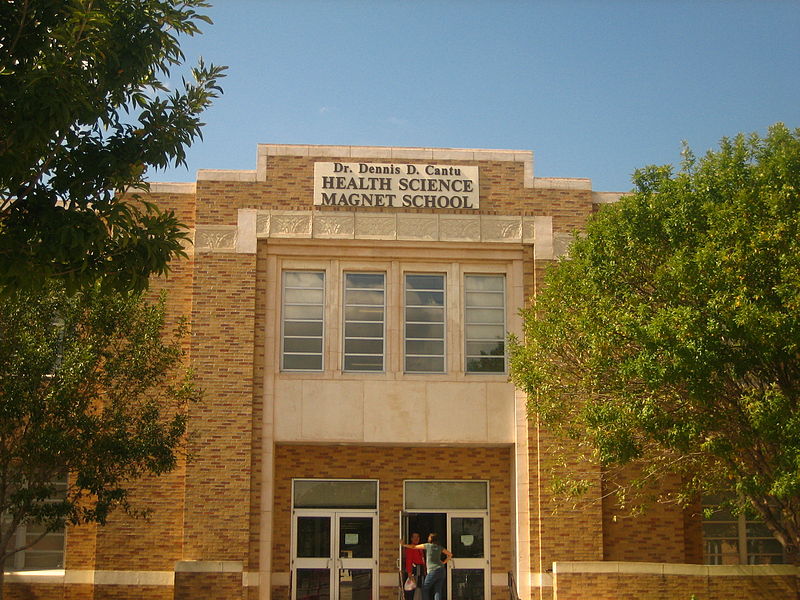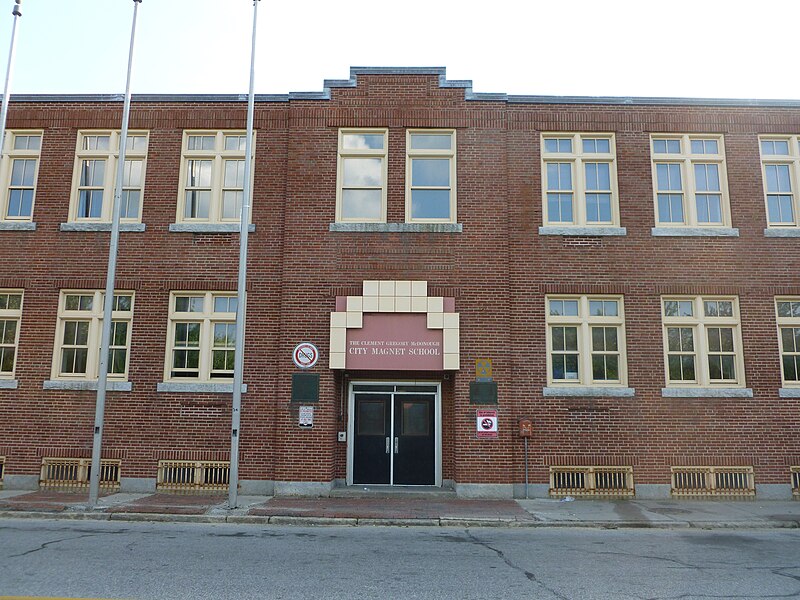In the U.S. education system, magnet schools are public schools with specialized courses or curricula. "Magnet" refers to how the schools draw students from across the normal boundaries defined by authorities (usually school boards) as school zones that feed into certain schools.
There are magnet schools at the elementary, middle, and high school levels. In the United States, where education is decentralized, some magnet schools are established by school districts and draw only from the district, while others are set up by state governments and may draw from multiple districts. Other magnet programs are within comprehensive schools, as is the case with several "schools within a school." In large urban areas, several magnet schools with different specializations may be combined into a single "center," such as Skyline High School in Dallas.
Other countries have similar types of schools, such as specialist schools in the United Kingdom. The majority of these are academically selective. Other schools are built around elite sporting programs or teach agricultural skills such as farming or animal breeding.
History

Magnet schools emerged in the United States in the 1970s as one means of remedying racial segregation in public schools, and they were written into law in Sec. 5301 of the Elementary and Secondary Education Authorization. Demographic trends following the 1954 Brown v. Board of Education Supreme Court decision revealed a pattern later characterized as white flight, the hypersegregation of African Americans and European Americans, as the latter moved to the suburbs.
At first, districts tried using involuntary plans which involved court-ordered attendance, the busing of children far from their homes, and building closer schools to achieve the required balance. Subsequently, voluntary school integration plans were developed. One approach educators within the public school system came up with was open schools. During the Open Schools movement of the 1970s, several ideas designed to influence public education were put into practice, including Schools without Walls, Schools within a School, Multicultural Schools, Continuation Schools, Learning Centers, Fundamental Schools, and Magnet Schools. "These schools were characterized by parent, student, and teacher choice, autonomy in learning and pace, non-competitive evaluation, and a child centered approach." Magnet schools have been the most successful of the ideas that originated from the Open Schools movement. It was expounded in 1971 by educator Nolan Estes, superintendent of Dallas Independent School District. The Magnet Schools Assistance Program was developed in the early 1980s as a way to encourage schools to address de facto racial segregation. Funds were given to school districts that implemented either voluntary desegregation plans or court orders to reduce racial isolation.
From 1985 to 1999, a United States district court judge required the state of Missouri to fund the creation of magnet schools in the Kansas City Public Schools in order to reverse the white flight that had afflicted the school district since the 1960s. The district's annual budget more than tripled in the process. The expenditure-per-pupil and the student-teacher ratio were the best of any major school district in the nation. Many high schools were given college-level facilities. Despite all the largesse, test scores in the magnet schools did not rise; the black-white gap did not diminish; and there was less, not greater, integration. Finally, on September 20, 2011, The Missouri Board of Education voted unanimously to withdraw the district's accreditation status effective January 1, 2012.
Districts started embracing the magnet school models in the hope that their geographically open admissions would end racial segregation in "good" schools, and decrease de facto segregation of schools in poorer areas. To encourage the voluntary desegregation, districts started developing magnet schools to draw students to specialized schools all across their districts. Each magnet school would have a specialized curriculum that would draw students based on their interests. One of the goals of magnet schools is to eliminate, reduce, and prevent minority group isolation while providing the students with a stronger knowledge of academic subjects and vocational skills. Magnet schools still continue to be models for school improvement plans and provide students with opportunities to succeed in a diverse learning environment.
Within a few years, in locations such as Richmond, Virginia, additional magnet school programs for children with special talents were developed at facilities in locations that parents would have otherwise found undesirable. This effort to both attract voluntary enrollment and achieve the desired racial balance met with considerable success, and helped improve the acceptance of farther distances, hardships with transportation for extracurricular activities, and the separation of siblings. Even as districts such as Richmond were released from desegregation court orders, the parental selection of magnet school programs has continued to create more racially diverse schools than would have otherwise been possible. With a wide range of magnet schools available, a suitable program could be found for more children than only the "bright" ones for whom the earliest efforts were directed.
Some 21st-century magnet schools have de-emphasized the racial integration aspects, such as Capital Prep Magnet School, a high school in Hartford, Connecticut. Capital Prep, a year-round school where more than 80% of its students are black and Latino, boasts a near-0% dropout rate; 100% of its 2009 senior class was sent to a four-year college. According to the school's principal, the goal is to prepare all of its students for college.
Enrollment and curriculum

Some magnet schools have a competitive entrance process, requiring an entrance examination, interview, or audition. Other magnet schools select all students who apply or use a lottery system, or a system combining some elements of competitive entrance and a lottery.
Most magnet schools concentrate on a particular discipline or area of study, while others (such as International Baccalaureate schools) have a more general focus. Magnet programs may focus on academics (mathematics, natural sciences, and engineering; humanities; social sciences; fine or performing arts) or may focus on technical/vocational/agricultural education. For example, the Environmental Sciences Magnet School at Mary Hooker in Hartford, CT integrates environmental sciences into its core curriculum of reading, math and social studies and also provides discrete classes in local and global environmental problems.
The Paideia philosophy is one used by magnet schools in the United States. “The Paideia philosophy celebrates the fundamental notion that to be fully educated is a lifelong adventure that only begins with an individual's formal schoolingâ€. The philosopher Mortimer Adler founded this philosophy in 1984. The Three Columns of Instruction are used to teach Paideia students: 1) didactic instruction of factual information; 2) intellectual coaching of skills; and 3) seminar discussion of ideas, concepts, and valueâ€.
See also

- Alternative school
- Charter school
- Education reform
- Exceptional education
- Homeschooling
- Magnet Schools of America
- Public education
- National Consortium for Specialized Secondary Schools of Mathematics, Science and Technology
- School choice
- Selective school
- Specialized high schools in New York City
References
External links
- Creating and Sustaining Successful Kâ€"8 Magnet
- Innovations in Education: Successful Magnet High Schools
- Innovations in Education: Creating Successful Magnet School Programs
- Capital Preparatory Magnet School
- Evaluation Toolkit for Magnet School Programs
- Magnet Schools of America
- Magnet Schools Assistance - U.S. Department of Education
- Public school Review - What is a Magnet School?
- Innovative magnet programs attract new attention, lots of students/ Special classes soaring in number and popularity - Houston Chronicle November 26, 1994
- How Gotham’s Elite High Schools Escaped the Leveller’s Ax by Heather Mac Donald
- Florida Statutes for New World School of the Arts
- Environmental Sciences Magnet School at Mary Hooker







0 komentar :
Posting Komentar